#From Jerusalem: Jericho
Text
LIMITED OFFERS From Jerusalem: Jericho, Jordan River and the Dead Sea Tour
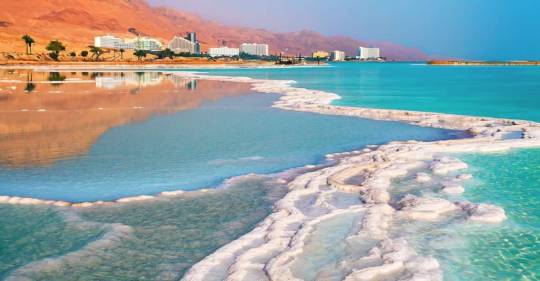
Secure Your Spot for the Most Popular Tour - From Jerusalem: Jericho, Jordan River and the Dead Sea Tour! , Are you ready for an unforgettable adventure? Look no further because From Jerusalem: Jericho, Jordan River and the Dead Sea Tour is here to exceed your wildest expectations! With its captivating attractions and thrilling experiences, From Jerusalem: Jericho, Jordan River and the Dead Sea Tour has become the ultimate choice for avid travelers like you.Due to its immense popularity, From Jerusalem: Jericho, Jordan River and the Dead Sea Tour has been consistently selling out, leaving many disappointed travelers without the chance to embark on this remarkable journey. That's why we strongly advise you to secure your tickets for From Jerusalem: Jericho, Jordan River and the Dead Sea Tour as soon as possible. Don't miss out on this incredible opportunity!To learn more about the complete description of From Jerusalem: Jericho, Jordan River and the Dead Sea Tour, its detailed itinerary, browse through our awe-inspiring photo gallery, and read reviews from our satisfied travelers, please visit our website at [ https://thingstodo9.com/from-jerusalem-jericho-jordan-river-and-the-dead-sea-tour/ ]. As a special bonus for visiting our website, you can also avail yourself of an exclusive discount on From Jerusalem: Jericho, Jordan River and the Dead Sea Tour!Join the ranks of the fortunate adventurers who have experienced the magic of From Jerusalem: Jericho, Jordan River and the Dead Sea Tour firsthand. From the moment you step into this mesmerizing journey, you'll be greeted with exceptional service, expert guides, and memories that will last a lifetime. Don't delay - start planning your From Jerusalem: Jericho, Jordan River and the Dead Sea Tour today!To secure your tickets or inquire further about From Jerusalem: Jericho, Jordan River and the Dead Sea Tour, please feel free to contact our dedicated customer service team at [ https://thingstodo9.com/from-jerusalem-jericho-jordan-river-and-the-dead-sea-tour/ ]. They are more than happy to assist you in making your dream adventure a reality.Don't let this opportunity slip away! Secure your spot on From Jerusalem: Jericho, Jordan River and the Dead Sea Tour now and get ready to embark on the adventure of a lifetime. We can't wait to be part of your unforgettable journey!
0 notes
Text

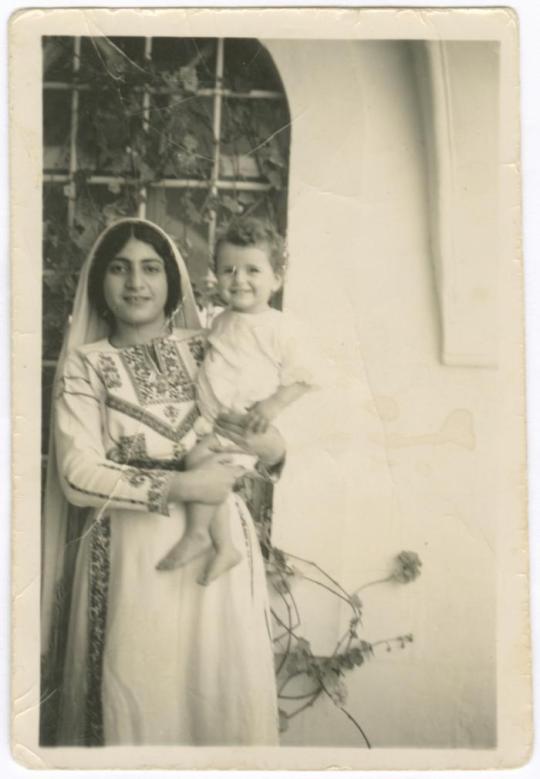


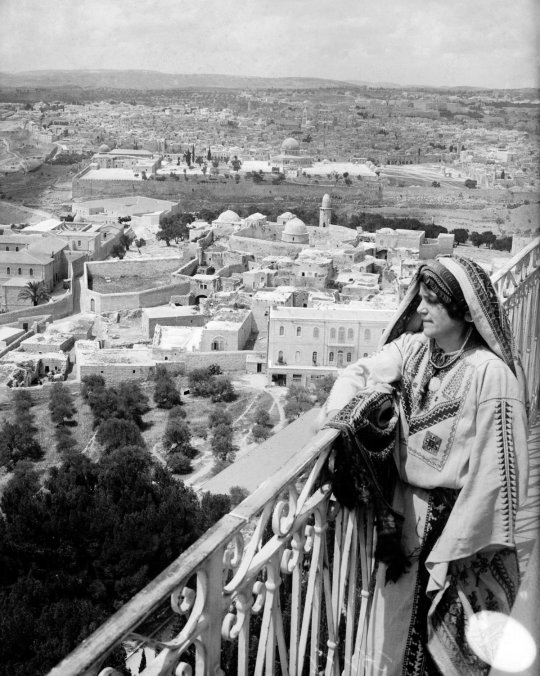
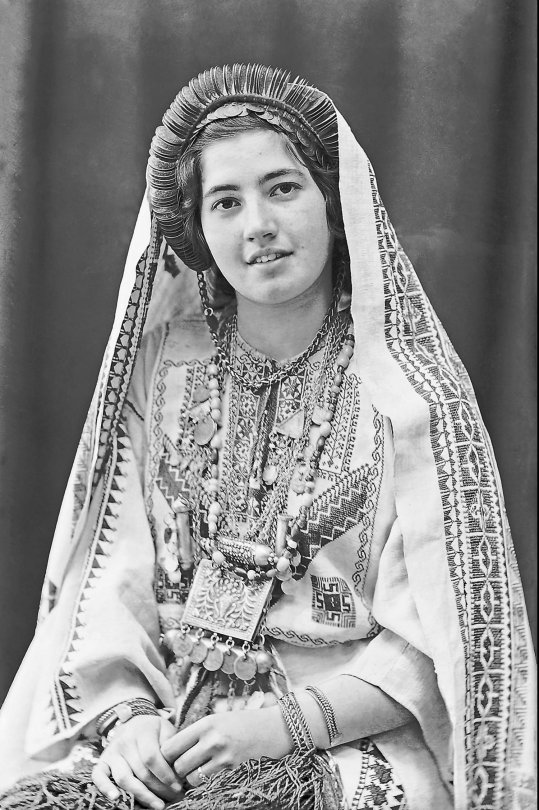

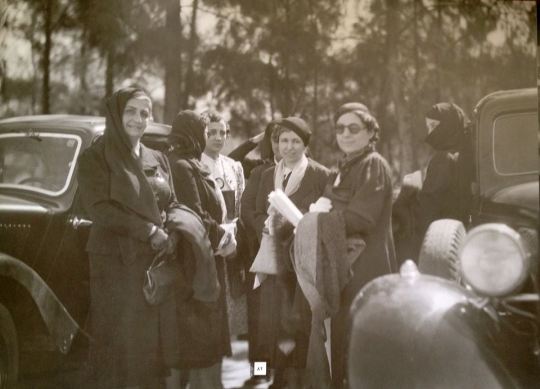
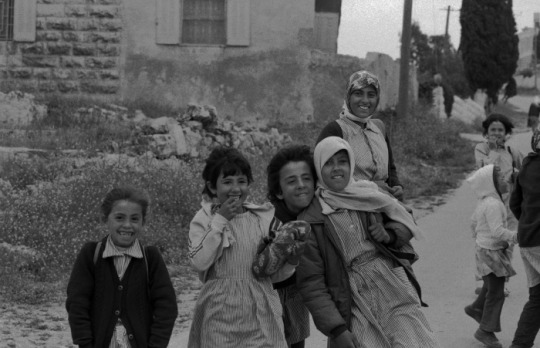

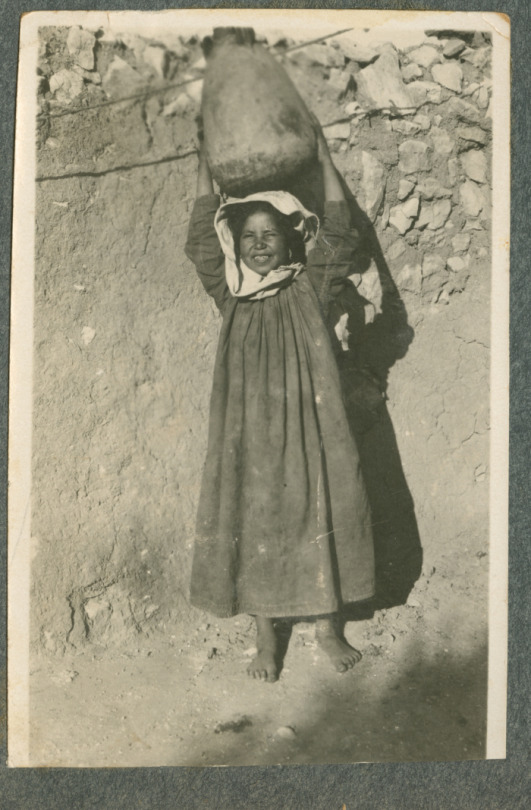


Moments from Palestine across generations and communities
(1) A Bedouin woman smiles in Jerusalem (1898-1914)
(2) Asma Aranki Holding a Child from Her Family at Their House, Birzeit (1948)
(3) Bedouin girls in Jericho (1918)
(4) An extended Palestinian family gathers in front of their house in the village of Beit Sahur, near Bethlehem (1918–35)
(5) From the Mount of Olives, a young woman looks out over eastern Jerusalem (1929)
(6) Ruth Raad, daughter of photographer Khalil Raad, in the traditional costume of Ramallah (1939)
(7) Standing in his neatly ironed shirt and shorts, George Sawabin poses for a studio photo (1942)
(8) Katingo Hanania Deeb, prepares to demonstrate in the 1936-1939 Arab Revolt -- which was a nationalist uprising by Palestinian Arabs against British colonial rule in relation to Palestinian independence and the land acquisition and pushout as a result of the mass Jewish immigration (1936)
(9) Young children walking home from school Beit Deqqo Village, the Occupied Palestinian West Bank, 1987
(10) Four young girls decorating vases in a ceramic workshop in Nablus (1920)
(11) A young Palestinian girl squints and smiles as she holds a jar on her head (1920-1950)
(12) The ancient craft of a Palestinian potter (1918-35)
(13) The mothers of Palestinian detainees' protest in Jerusalem (1987)
Source(s): The British Mandate Jerusalemites (BMJ) Photo Library, Palestinian Museum Digital Archives, The Jerusalem Story + Khalil Raad
Please support, share, cite, and (if financially able) fund these organizations and public storytellers for their rebellious histories and community work!
#decolonization#our world#our history is your history#people#free palestine#palestine#indigenous rights#art of making#and manifesting#history is not neutral#futurepast
4K notes
·
View notes
Text

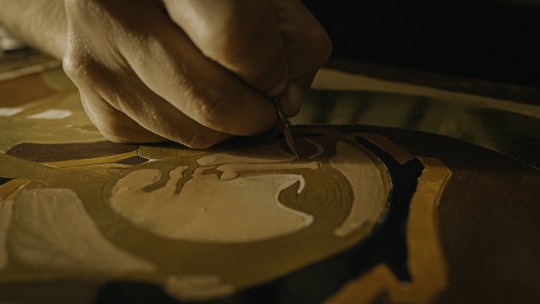

Palestinian icon painter Nicola Juha working at his atelier in Bethlehem
"Iconography is not just a painting on wood or canvas; it is the connection of the soul with God. Each icon carries deep meaning and symbolism, and its creation is a challenging spiritual and artistic process.
Creating an icon requires calmness, time and patience. Sometimes it takes months, sometimes years, before it is completed. This time is necessary to allow not only the artist, but also his heart and soul to imprint on it. Every brushstroke, every touch of paint is a prayer that connects a person to the spiritual world and has its place and meaning. The colours are carefully selected and blended to create bright and vibrant tones.
In creating our icons, we use raw materials directly from the Holy Land - water from the Jordan River, stones and clay from the area between Jerusalem and Jericho. This makes our icons a fusion of history and tradition. The technique we use has its roots in ancient Greek and Egyptian traditions that go back more than 2,000 years.
Each icon has its own story and message. They are images of faith, love and devotion. For the icon creator, it is not just art, it is a prayer in colours and shapes. Each icon, whether small or large, carries a piece of heaven within it. That is what makes them so precious and unique."
#palestine#iconography#looked him up again bc that post’s going around and he has a new website and seems to be doing well!
823 notes
·
View notes
Text


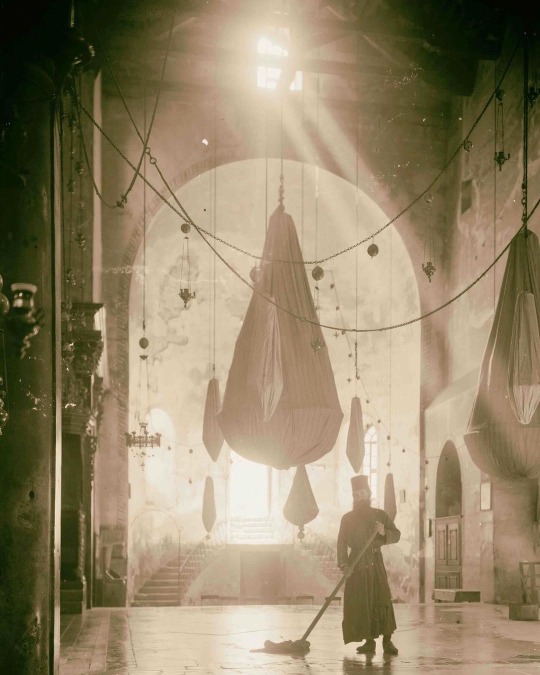
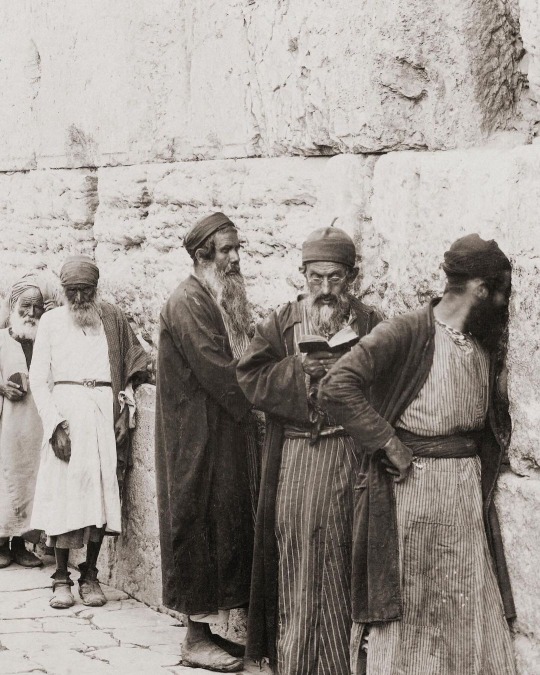




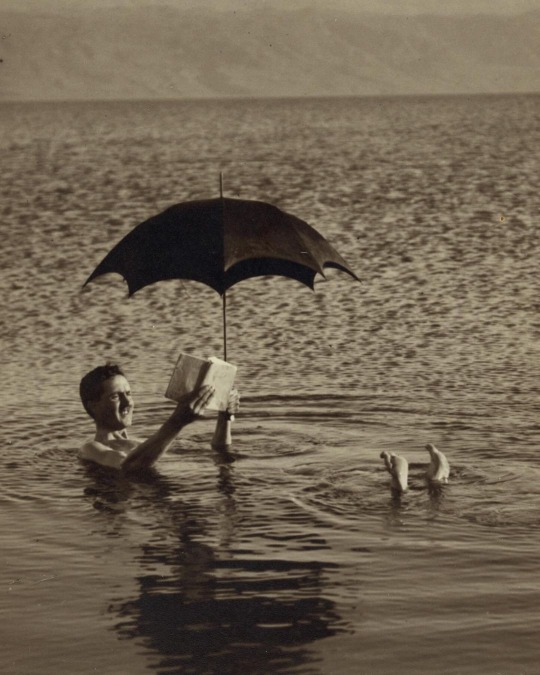
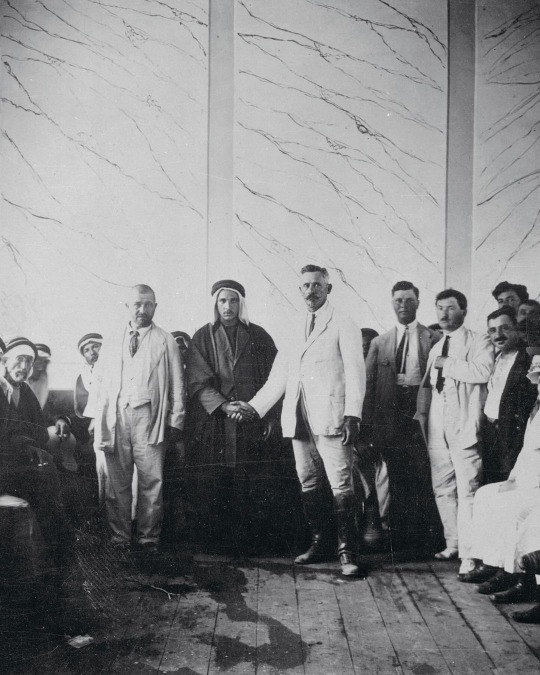
Everyday life in Palestine before 1948📸 Getty
a woman wearing traditional Palestinian clothing, 1925
men in Jericho sharing a meal, 1920
monk sweeping floor in Church of Nativity, Bethlehem, 1898
Jews gathering at the Wailing Wall, 1895
Romani women, Palestine, 1893
Jerusalem, 1903
Sikhs helping protect Jewish quarter in Jerusalem, c. 1900
Woman from Nazareth, 1870
Man in Dead Sea, 1920
A peace dinner with Arabs and Jews of Palestine, 1926
445 notes
·
View notes
Photo
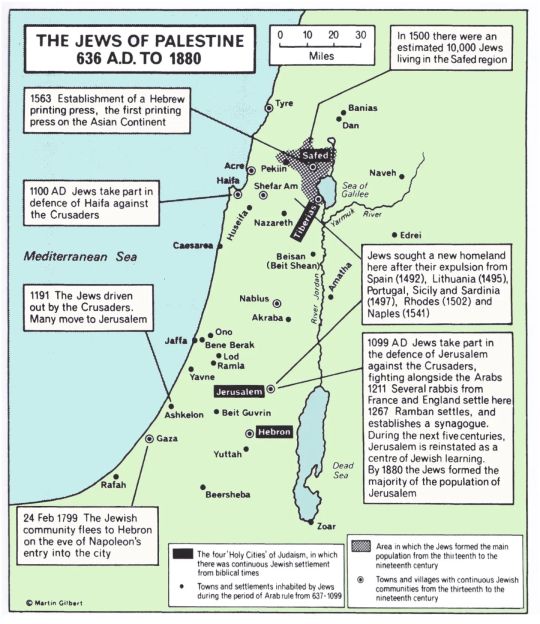
Jews in Palestine from the 7th century to the 19th century.
From “Atlas of Jewish History”, Martin Gilbert, Routledge, 1969, 2010
via cartesdhistoire
In 636, at the Battle of Yarmouk, the Arabs captured Tiberias and Galilee. Then they besieged and took Jerusalem and Caesarea before completing their conquest in 641 with the capture of Ascalon.
From the 8th century, the largest Jewish community was found in Ramleh, then, at the time of the Latin kingdom of Jerusalem (1099-1291), the most important Jewish communities were those on the coast: Tyre, Acre and Ascalon.
Between 1260 and 1516, relations between the Jews and the Mamluk power, fanatical and intolerant, were bad. The most important communities are in the interior (the ports were evacuated in the 13th century for fear of invasions): Jerusalem especially, Safed, Gaza, Hebron, a few villages in Upper Galilee. Pilgrimage to Jewish holy places – the “ziara” – is already very widespread there.
The Turks conquered Palestine in 1516. The community of Safed experienced great expansion with the cultural and technical contribution of Judeo-Iberian refugees.
But throughout the 19th century, Muslim populations also settled in Palestine: some 20,000 Egyptians during the conquests of Mehemet-Ali (in Gaza, Jaffa and Jericho), then several tens of thousands of Muslims, coming from the former Ottoman territories of the Balkans and the Caucasus. The sultan grants them land on favorable terms in Galilee and the coastal plain of Sharon. The accounts of European travelers in Palestine attest to the existence of numerous villages where Arabic is not spoken.
From 1840, the Jewish population of Jerusalem grew at a much faster rate than that of other communities, reaching 11,000 people in 1870, or half of the total population, and this before the major movements of Jewish immigration which began. from the 1880s; the Jewish population has since retained its majority status.
In 1872, the Palestinian population (Bedouins excluded) was 381,954 inhabitants (85% Muslims, 11% Christians and 4% Jews).
205 notes
·
View notes
Text


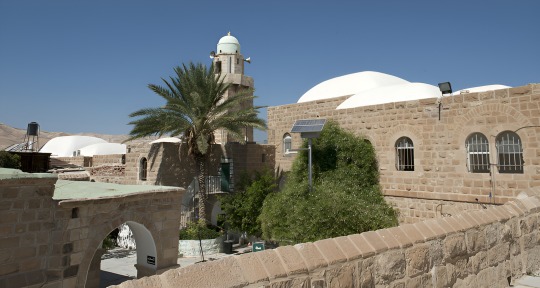



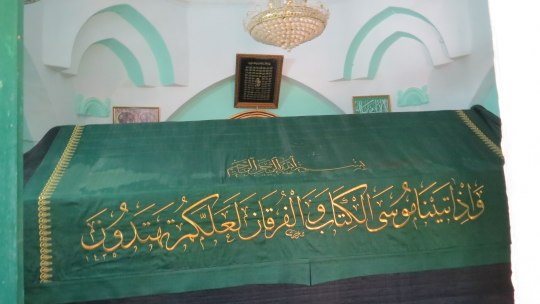
nabi musa (prophet moses) mosque/maqām in jericho governorate, palestine. local muslim tradition holds that moses was buried here. where exactly this tradition comes from is unknown.
every year, one friday before good friday in the greek orthodox calendar, a yearly pilgrimage from jerusalem to nabi yusha takes place, after which a festival in moses's honor is held. this began in the mid-19th century, though palestinian tradition holds that its origins lay in saladin's recapture of jerusalem from crusaders in 1187. this continues to hold symbolic importance today. the structure itself was likely built by mamluk sultan baybars eight decades later.
since the 1967 occupation, the pilgrimage was prohibited for 20 years (most likely due to association with the 1920 nabi musa riots) before being permitted again. since then, it's been prohibited on and off - most recently after the second intifada in 2000, before being renewed in 2007.
208 notes
·
View notes
Text
Hey check this out
I was making a zine (solarpunk ofc) and decided to use a bunch of old National Geographic magazines to cut up and use in a scrappy diy scrapbook fashion and of course I started reading them. This one in particular:

It caught my eye because it’s from September 1980 & talks about the Middle East. My brain wonders if they mention Palestine and they do! I copied the text for accessibility, but I put pictures at the end of the original pages.
“Jerusalem: reunited or occupied? The question has divided the city's 400,000 Jews and 100,000 Arabs since Israel annexed East Jerusalem in 1967.
BEIRUT, JANUARY 1975. Armed soldiers lead me through labyrinthine back streets, up a dark stairway to a midnight rendez-vous. Only a bare bulb lights the temporary command post; Yasir Arafat, chairman of the Palestine Liberation Organization, seldom dares spend two days in the same place. “Our argument is not with the Jews” He tells me. "We are both Semites. They have lived with us for centuries. Our enemies are the Zionist colonizers and their backers who insist Palestine belongs to them exclusively.
We Arabs claim deep roots there too."
Two decades ago Palestinians were to be found in United Nations Relief Agency camps at places like Gaza and Jericho, in a forlorn and pitiable state. While Palestinian spokesmen pressed their case in world cap-itals, the loudest voice the world heard was that of terrorists, with whom the word Palestinian came to be associated. Jordan fought a war to curb them. The disintegration of Lebanon was due in part to the thousands of refugees within its borders.
Prospects for peace brightened, however, when President Anwar Sadat of Egypt, most powerful of the Arab countries, made his historic trip to Israel in November 1977. A year later Sadat and Israeli Prime Minister Menachem Begin signed the Camp David accords, a framework for the return of the occupied Sinai Peninsula to Egypt.
The former enemies established diplomatic relations and opened mail, telephone, and airline communications.
The Camp David accords also addressed the all-important Palestinian question but left it vague. Sadat insists that any lasting peace depends on an eventual Palestinian homeland in the Israeli-occupied West Bank and Gaza. Israel agrees to limited autonomy for those regions, but, fearful of a new and hostile Palestinian state suddenly planted on its borders, insists that Israeli troops must maintain security there.
Crowded Rashidiyah refugee camp, set among orange groves south of the ancient Phoenician port of Tyre in Lebanon, lies on the front lines. Frequent pounding by Israeli military jets and warships seeking PLO targets has war-hardened its population, some 13,700 Palestinians.
At the schoolyard I watched a solemn flag raising. Uniformed ashbal, or lion cubs, stood rigid as color guards briskly ran up the green-white-and-black Palestinian flag.
Ranging in age from 8 to 12, they might have been Cub Scouts— except for the loaded rifles they held at present arms. Behind them stood two rows of girls, zaharat, or little flowers. Same age, same weapons.
Over lunch of flat bread, hummus, yo-gurt, and chicken I commented to my hosts, a group of combat-ready fedayeen, that 30 years of bitter war had settled nothing nor gained the Palestinians one inch of their homeland. Was there no peaceful way to press their cause?
"Yes, and we are doing it. Finally, after 30 years, most countries in the United Nations recognize that we too have rights in Palestine. But we feel that until your country stops its unconditional aid to Israel, we have two choices: to fight, or to face an unmarked grave in exile."
AFTER CROSSING the Allenby Bridge from Amman, I drove across the fertile Jordan Valley through Arab Jericho and past some of the controversial new Jewish settlements: Mitzpe Jericho, Tomer, Maale Adumim, Shilat. Then as I climbed through the steep stony hills to Jerusalem, I saw that it too had changed. A ring of high-rise apartments and offices was growing inexorably around the occupied Arab side of the walled town. Within the wall, too, scores of Arab houses had been leveled during extensive reconstruction.
"Already 64 settlements have been built on the West Bank," said a Christian Palestinian agriculturist working for an American church group in Jerusalem. "And another 10 are planned," he said. Unfolding a copy of the master plan prepared in 1978 by the World Zionist Organization, he read: "Real-izing our right to Eretz-Israel... with or without peace, we will have to learn to live with the minorities...
The Israeli Government has reaffirmed the policy. In Prime Minister Menachem Begin's words: "Settlement is an inherent and inalienable right. It is an integral part of our national security."
"Security" is a word deeply etched into the Israeli psyche. The country has lived for 30 years as an armed camp, always on guard against PLO raids and terrorist bombings.
Whenever such incidents occur, the response is quick: even greater retaliation.
In Jerusalem I met with David Eppel, an English-language broadcaster for the Voice of Israel. "We must continue to build this country. Israel is our lawful home, our des-tiny. We have the determination, and an immense pool of talent, to see it through." His cosmopolitan friends a city plan-ner, a psychology professor, an author gathered for coffee and conversation at David's modern apartment on Jerusalem's Leib Yaffe Road.
Amia Lieblich's book, Tin Soldiers on Jerusalem Beach, studies the debilitating effects almost constant war has had on life in the Jewish state, a nation still surrounded by enemies. As she and her husband kindly drove me to my hotel in Arab Jerusalem afterward, some of that national apprehension surfaced in the writer herself.
"We don't often come over to this part of town," she said. "Especially at night."
I DROVE OUT of the Old City in the dark of morning and arrived a few hours later at the nearly finished Israeli frontier post, whence a shuttle bus bounced me through no-man's-land to the Egyptian ter-minal. As a result of the Egyptian-Israeli treaty, it was possible for the first time since 1948 to travel overland from Jerusalem to Cairo. An Egyptian customs man opened my bags on a card table set up in the sand. I took a battered taxi into nearby El Arish, to a sleepy bank that took 45 minutes to convert dollars into Egyptian pounds, Then 1 hired a Mercedes for the
200-mile run across the northern Sinai des-ert, the Suez Canal, and the Nile Delta. By sundown Cairo was mine.
Despite official government optimism, I found many in Cairo worried that President Sadat's bold diplomatic gestures might fail.
The city was noticeably tense as Israel officially opened its new embassy on Mohi el-Din Abu el-Ez Street in Cairo's Dukki quarter. Black-uniformed Egyptian troops guarded the chancery and nearby intersections as the Star of David flew for the first time in an Arab capital. Across town, police with fixed bayonets were posted every ten feet around the American Embassy. Others were posted at the TV station and the larger hotels. Protests were scattered, mostly peaceful. None disturbed the cadence of the city.
Welcoming ever larger delegations of tourists and businessmen from Europe and the U.S., Cairo was busier than ever-and more crowded. Despite a building boom, many Egyptians migrating from the countryside, perhaps 10,000 a month, still find housing only by squatting among tombs at the City of the Dead, the huge old cemetery on the southeast side of the capital.
Even with the new elevated highway and wider bridge across the Nile, half-hour traffic standstills are common. Commuters arrive at Ramses Station riding even the roofs of trains, then cram buses until axles break.
Cairo smog, a corrosive blend of diesel fumes and hot dust from surrounding des-erts, rivals tear gas.
Despite the rampant blessings of prog-ress, Cairo can still charm. In the medieval Khan el-Khalili bazaar near Cairo's thousand-year-old Al-Azhar University, I sought out Ahmad Saadullah's sidewalk café. I found that 30 piasters (45 cents) still brings hot tea, a tall water pipe primed with tobacco and glowing charcoal, and the latest gossip. The turbaned gentleman on the carpeted bench opposite was unusually talk-ative; we dispensed with weather and the high cost of living and got right to politics:
"Of course I am behind President Sadat, but he is taking a great risk. The Israelis have not fully responded. If Sadat fails, no other Arab leader will dare try for peace again for a generation."
Across town at the weekly Akhbar El-Yom newspaper, one of the largest and most widely read in the Middle East, chief editor Abdel-Hamid Abdel-Ghani drove home that same point.
"What worries me most is that President Sadat's agreement with Israel has isolated Egypt from our brother nations," he told me. "When Saudi Arabia broke with us, it was a heavy loss. The Saudis are our close neighbors. Now they have canceled pledges for hundreds of millions in development aid to Egypt. Some 200,000 Egyptians-teach-ers, doctors, engineers live and work in the kingdom.
"And Saudi Arabia, guardian of the holy cities of Mecca and Medina, remains for Muslim Egypt a spiritual homeland."
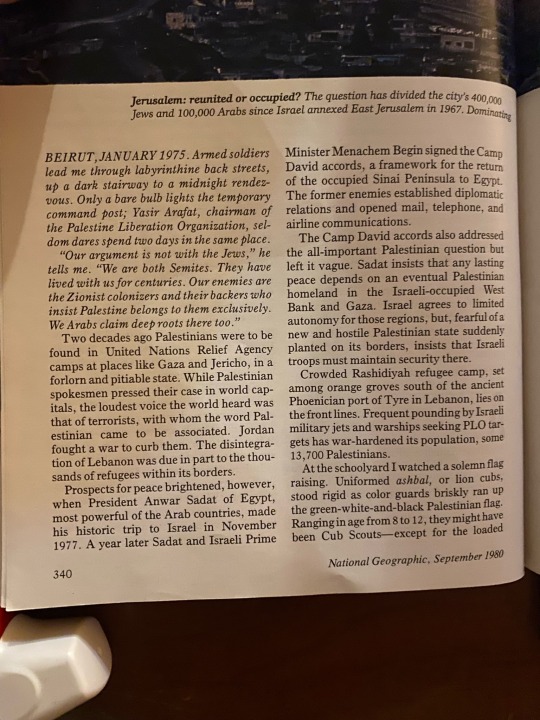

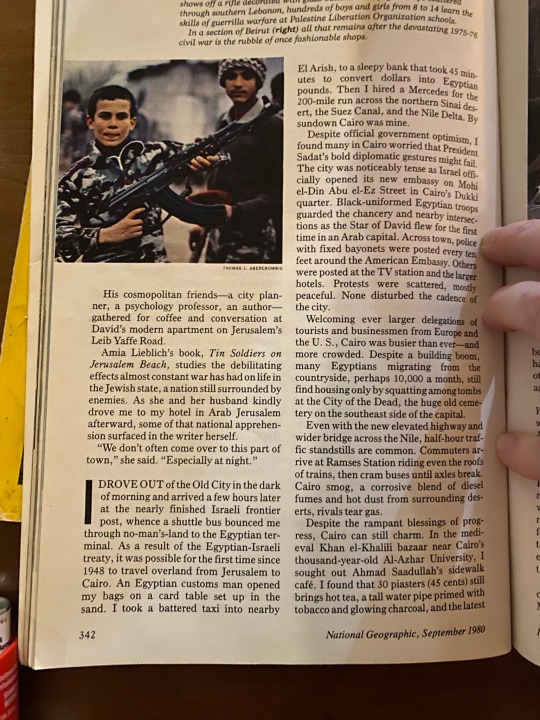
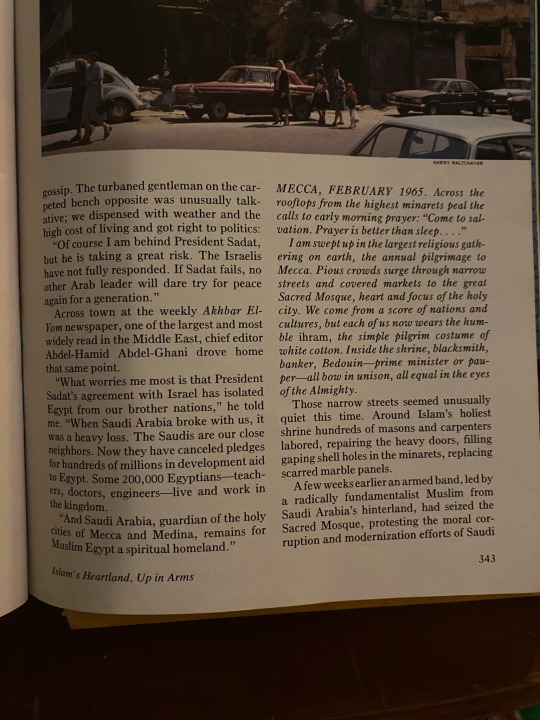
This magazine was published before my mom was born, and yet the sentiments have basically unchanged. An interesting look at the past, and more proof this didn’t start October 7th. (But imagine my followers already knew that)
#Palestine#free palestine#from the river to the sea palestine will be free#national geographic#September 1980
55 notes
·
View notes
Text
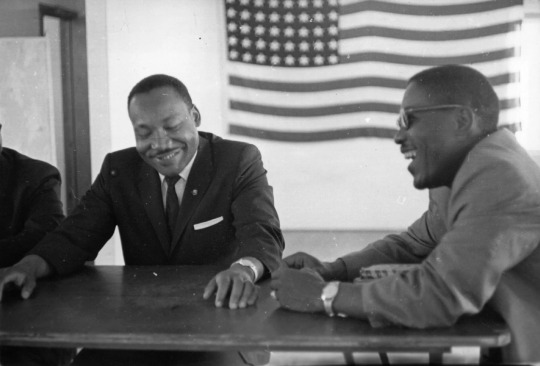
[T]he Jericho road is a dangerous road. I remember when Mrs. King and I were first in Jerusalem. We rented a car and drove from Jerusalem down to Jericho. And as soon as we got on that road, I said to my wife, "I can see why Jesus used this as the setting for his parable." It's a winding, meandering road. It's really conducive for ambushing. You start out in Jerusalem, which is about 1200 miles—or rather 1200 feet above sea level. And by the time you get down to Jericho, fifteen or twenty minutes later, you're about 2200 feet below sea level. That's a dangerous road. In the days of Jesus it came to be known as the "Bloody Pass." And you know, it's possible that the priest and the Levite looked over that man on the ground and wondered if the robbers were still around. Or it's possible that they felt that the man on the ground was merely faking. And he was acting like he had been robbed and hurt, in order to seize them over there, lure them there for quick and easy seizure. And so the first question that the priest asked—the first question that the Levite asked was, "If I stop to help this man, what will happen to me?" But then the Good Samaritan came by. And he reversed the question: "If I do not stop to help this man, what will happen to him?"
That's the question before you tonight. Not, "If I stop to help the sanitation workers, what will happen to my job. Not, "If I stop to help the sanitation workers what will happen to all of the hours that I usually spend in my office every day and every week as a pastor?" The question is not, "If I stop to help this man in need, what will happen to me?" The question is, "If I do not stop to help the sanitation workers, what will happen to them?" That's the question. Let us rise up tonight with a greater readiness. Let us stand with a greater determination. And let us move on in these powerful days, these days of challenge to make America what it ought to be. We have an opportunity to make America a better nation. And I want to thank God, once more, for allowing me to be here with you.
—Martin Luther King Jr, "I've Been to the Mountaintop" speech
delivered at the Mason Temple (Church of God in Christ Headquarters), Memphis, Tennessee, Apr 3, 1968
[Robert Scott Horton]
72 notes
·
View notes
Text
🔅Thu morning - ISRAEL REALTIME - Connecting to Israel in Realtime
A good Chol HaMoed! Moadim l’Simcha!
🔘 SUMMARY TODAY 🔘
⚠️ HEATWAVE.. VERY HOT. Don’t leave children in the car! Check on elderly! Beware heat stroke!
Israel is suffering a desert heatwave, temperatures very hot, very dry - and beaches, parks and the Kinneret are PACKED. The temperatures should drop to normal spring temps tomorrow with a cooling trend late next week and even possible light rain.
🔘 LEBANON - The ‘tit-for-tat’ pace of attacks has increased, again, with Israel striking more often, larger hits, more locations, and deep into Lebanon at Hezbollah sites. Hezbollah has been firing larger rocket barrages, sending more drones, more anti-tank missiles, and is threatening to increase strikes to target northern Israeli cities. How long can this go on before it goes too far? Unknown.
🔘 GAZA - Remember the food crisis and the demand for 500 trucks a day? At 400 trucks a day Gaza is so awash in FREE FOOD that Gazans are throwing away the airdropped military meals, and vendors are selling (received free) products for 1/4 the price they would be found in Israeli supermarkets. The major product in demand: cigarettes.
In a “LIE OF THE DAY” moment, in January Hamas put out videos of them digging graves in the Nasser and Shifa hospital parking lots. In the past week videos when out of “OMG WE FOUND A MASS GRAVE IN THE HOSPITAL PARKING LOT - WHAT HAVE THE ISRAELIS DONE?”. Of course UN horrified, investigation demanded, etc. Complicating it, Israel did dig up the graves sites to check if any of the bodies were Israeli hostages, and then put them back after determining they were not. Here’s a link from Al Jazeera of Hamas creating the “mass grave” that was just found -> https://www.aljazeera.com/news/2023/11/14/gazas-al-shifa-hospital-forced-to-bury-dead-patients-in-mass-grave
🔘 HAMAS - Video of leader Sinwar touring above ground debunked, it’s from 2017. Suddenly their political types are talking about flexibility and deal possibilities, after rejecting ridiculously generous terms from Israel. They’re feeling some political pressure.
🔘 RAFAH - It appears Israel is lined up and ready militarily to attack Gaza’s last city and Hamas stronghold Rafah. What’s the hold up? We hear of consultations with the U.S. and meetings in Egypt.
🔘 JUDEA-SAMARIA - Daily attacks at security checkpoints and Jewish town fences and gates. Conversely, the IDF is doing daily incursions into the larger Arab cities, battles with local terror groups and arrests in Jenin, Shechem, Tubas, Qalqilya, Jericho, Hebron among others. The enhanced containment strategy is not enough, and the commanding general has quit.
🔘 PROTESTS & POLITICS - A solid coalition of distraught hostage families and anti-government-coalition protestors has formed, with weekly sizable protests in Tel Aviv and occasional smaller semi-violent protests in Jerusalem. The protest coalition doesn’t seem to be growing, but it does seem to be becoming more aggressive as they continue to have no effective impact - though some say they are directly having counter-productive impact as videos of the protests are used in Hezbollah, Hamas and Iranian videos to “show Israel falling apart under the onslaught of the axis of resistance”.
For the most part these protests have been given wide latitude, particularly with the involvement of hostage families. But as they are becoming more aggressive, the police have been in response.
The war coalition - the active government, remains remarkably stable and quiet in public for Israeli politicians. There is a lot of public speculation and polls around future elections, parties and politicians. All is speculation until the war and results settle.
24 notes
·
View notes
Text
*throat grabs knives* did you ever think that maybe, you should stop running from the inherent pain and agony of living, and that devoting yourself to creating a perfect paradise is an impossible, beautiful dream that you will only hurt yourself trying to achieve?
that by killing and bleeding for a vision of eden you will never be able to carve from the worm-infested husk of this planet, you've closed yourself off from everything good and lovely?
that if you keep running--and you will run forever, knives, if you continue digging this hole--you will never, ever be happy?
you think your brother is the sick one and that if you could just cure him, just fix him, everything will be okay again. but what then? what then, knives? you can't go back, and you won't go forward. for you, there's nothing ahead but unhappiness. there's nothing ahead but rivers of blood. there's no jerusalem, there's no eden. the city of july is your jericho, and the walls are tumbling down.
#trigun#trigun stampede#millions knives#goes insane goes insane goes insane#this is of course written in preparation for knives's inevitable final act breakdown
169 notes
·
View notes
Text

The Most Important Commandment
25 One day an expert in religious law stood up to test Jesus by asking him this question: “Teacher, what should I do to inherit eternal life?”
26 Jesus replied, “What does the law of Moses say? How do you read it?”
27 The man answered, “‘You must love the Lord your God with all your heart, all your soul, all your strength, and all your mind.’ And, ‘Love your neighbor as yourself.’”
28 “Right!” Jesus told him. “Do this and you will live!”
29 The man wanted to justify his actions, so he asked Jesus, “And who is my neighbor?”
Parable of the Good Samaritan
30 Jesus replied with a story: “A Jewish man was traveling from Jerusalem down to Jericho, and he was attacked by bandits. They stripped him of his clothes, beat him up, and left him half dead beside the road.
31 “By chance a priest came along. But when he saw the man lying there, he crossed to the other side of the road and passed him by. 32 A Temple assistant walked over and looked at him lying there, but he also passed by on the other side.
33 “Then a despised Samaritan came along, and when he saw the man, he felt compassion for him. 34 Going over to him, the Samaritan soothed his wounds with olive oil and wine and bandaged them. Then he put the man on his own donkey and took him to an inn, where he took care of him. 35 The next day he handed the innkeeper two silver coins, telling him, ‘Take care of this man. If his bill runs higher than this, I’ll pay you the next time I’m here.’
36 “Now which of these three would you say was a neighbor to the man who was attacked by bandits?” Jesus asked.
37 The man replied, “The one who showed him mercy.”
Then Jesus said, “Yes, now go and do the same.”
— Luke 10:25-37 | New Living Translation (NLT)
Holy Bible, New Living Translation, copyright © 1996, 2004, 2015 by Tyndale House Foundation. All rights reserved.
Cross References: Deuteronomy 6:4-5; Deuteronomy 6:24; Leviticus 18:15; Leviticus 19:18; Isaiah 58:7; Matthew 10:5; Matthew 18:28; Matthew 19:16; Matthew 24:34; Mark 8:34; Luke 9:52; Luke 10:38; Luke 16:15; Luke 18:31; Luke 19:28
Read full chapter
The Greatest Commandment by Mark Jones
What is the meaning of the Parable of the Good Samaritan?
#Jesus#parables#the Greatest Commandment#the Good Samaritan#lesson#love#neighbor#Gospel of Luke#Luke 10:25-37#New Testament#NLT#New Living Translation Bible#Tyndale House Foundation
11 notes
·
View notes
Text

Luca Giordano (Italian, 1634-1705)
Le Bon Samaritain, ca.1650
Musée des Beaux-Arts de Rouen
“Do to others as you would have them do to you.” Luke 6:31
One of Jesus’s most well-known parable appears only in the Gospel of Luke but is very much a part of His message throughout His ministry. It is the Parable of the Good Samaritan.
“A man was going down from Jerusalem to Jericho, and fell into the hands of robbers, who stripped him, beat him, and went away, leaving him half dead. Now by chance a priest was going down that road, and when he saw him, he passed by on the other side. So likewise a Levite, when he came to the place and saw him, passed by on the other side. But a Samaritan while traveling came near him; and when he saw him, he was moved with pity. He went to him and bandaged his wounds, having poured oil and wine on them. Then he put him on his own animal, brought him to an inn, and took care of him. The next day he took out two denarii, gave them to the innkeeper, and said, ‘Take care of him; and when I come back, I will repay you whatever more you spend.’ Which of these three, do you think, was a neighbor to the man who fell into the hands of the robbers?” He said, “The one who showed him mercy.’ Jesus said to him, ‘Go and do likewise’“ (Luke 10:30-37).
#samaritain#le bon samaritain#the good samaritan#samaritan#art#fine art#christian art#christianity#christentum#catholic#catholic art#fine arts#oil painting#traditional art#the bible#christian#european art#classical art#european#mediterranean#europe#europa#italian art#italy#italian#italian peninsula
72 notes
·
View notes
Text
Amin al-Husseini docu: part 8
Part 1 | Part 2 | Part 3 | Part 4 | Part 5 | Part 6 | Part 7 | Part 8 | Last
Translator's notes:
-> Erwin Rommel was the commander of the Nazi forces in North Africa. They landed in Tunisia and were moving eastward, towards the Land of Israel. Rommel was stoppsed at the Second El-Alamein battle, in November 1942.
-> Walter Rauff was appointed as, among other things, the head of a unit called Einsatzgruppe Egypt (similarly named to the Einsatzgruppen in Europe, the "death squads" in charge of exterminating the Eastern European Jews, and which according to the latest research shot to death at least 2.5 million Jewish men, women and children in the shooting pits there). Einsatzgruppe Egypt was stationed in Athens, awaiting deployment in the Land of Israel once it would be occupied by Rommel's forces. The unit of 24 men was supposed to instruct the local Arabs, recruited by the Mufti, in how to exterminate Jews in gas chambers that were to be built in the Dotan Valley.
-> Prof. Yossi ben-Artzi is actually presented by the docu as "researched Operation Atlas," but I can't in good conscience write that, when he was actually researching The Templers. They are a German radical sect, which was established in 1861, and aspired to form the "perfect Christian society" to speed up the return of Jesus, which could also be helped by colonizing Israel. They began to do so around the end of the 1860's. This sect views Jews as denied salvation, since they didn't accept Jesus. At the peak of the Templers' colonization in Israel, they had somewhere between 900 to 1,200 adults, with a total community size of around 2,000 members living here. In the 1930's, they greatly identified with the Nazis, and at least 300 adult Templers were also officially members of the Nazi party. They even had local chapters of the Nazi party and the Hitler Jugend (Hitler youth) at their colonies in Israel. By 1934, there were reports of the Templers spreading Nazi ideology to local Arabs in Israel. Templer men were drafted into the Nazi army (the Wehrmacht) on Aug 20, 1939. Some of them left for Germany with their families, altogether 550 people. The British expelled most of those remaining to Australia. The few left were expelled in 1948, following Israel's Independence War. Israel paid the sect reparations for the property they had to leave behind (most of which was confiscated by the British). Today, there are still about 1,300 Templers living in Australia (with a center in Melbourne) and 700 in Germany. Their main center there is in Stuttgart, where they have their own conference hall, archive and monthly newspaper.
(in the pic: The Fast Hotel in Jerusalem, displaying several country flags along with the Nazi one in 1933)

-> Operation Atlas included 5 parachutists. The three German ones were Kurt Wieland, who headed a local Hitler Jugend chapter and left in 1936 for Germany to join the Nazi army, Friedrich Deininger, who helped the Arabs during the 1936-1939 Arab revolt (in which many Jews and Brits were targeted in Israel) and was incarcerated for this by the British, but he managed to escape to Germany, and Werner Frank, who had joined the Hitler Jugend in 1934 already. The two Arabs were Abdul Latif, who had participated in the Arab revolt, was expelled for it by the Brits to Iraq, but ended up becoming one of the Mufti's assistants in Berlin, and Hasan Salama, one of the leaders of the Arab revolt (during which he also killed many Arabs and gained from stolen property), after which he fled to Lebanon, then Syria, where he joined the Mufti on his way to Iraq, and finally to Germany. Salama became one of the Arab leaders during Israel's Independence War, and in fact he led the attack on bus 2904 from Netanya to Jerusalem, which is the anti-Jewish attack that started the war on Nov 30, 1947.

-> The participants of Operation Atlas parachuted east of Jericho on Oct 6, 1944. Some of their gold coins got the local Arabs talking, leading the British police to them. By Oct 11, even the Jewish press in Israel published the info on the strangers who had parachuted there. On Oct 15, the Brits captured Wieland, Frank and Latif. On Oct 16, they formally published this info. A few days later, they called off the search for the remaining two men. Deininger was captured in 1946, when he tried to contact his family, and Salama, who oversaw the start of Israel's Independence War, was eventually killed in a battle not too far from Rosh Ha'Ayin, the area where the springs the operation is said to have targeted are, and the same zone that Salama himself was from.
-> Decades after the war, Professor ben-Artzi, out of admiration for some of the Templers' colonialist accomplishments in Israel, lived with them in Stuttgart to gain their trust and study them. He was told by one man, who had returned from Australia, that the (then undisputed) story of Operation Atlas' goal being to poison Tel Aviv's water is untrue. According to ben-Artzi, 7 years later the man confessed to be the Nazi Waffen SS soldier Werner Frank, and it's his testimony that the professor is mostly basing his assessment of Operation Atlas on.
-> I'll offer my POV on Operation Atlas, but it's obviously just my personal opinion. I do think Frank had motivation to deny his complicity in what would have been a mass murder, for his own sake and that of his sect. I also don't know why his testimony should be seen as any more reliable than that of so many other Nazi criminals, who after the end of WWII, denied some of the facts or their own motivation. I do believe the substance the parachutists were carrying was poison. Other than Professor ben-Artzi, no historian disputes this, they mainly argue what the poison was for. Beyond the fact that black pepper is a much easier way to throw dogs off, poison specifically is a really dumb idea for that task, because it's bound to leave a trail of dead dogs that would lead back to the parachutists. And of course, the Mufti was a raging genocidal antisemite, obsessed with making sure that even Jews outside of Israel would be exterminated, so why in the world would he be so involved, and even emotionally invested (calling the parachutists his sons) if the operation was not targeting Jews specifically?
(for all of my updates and ask replies regarding Israel, click here)
#israel#antisemitism#israeli#israel news#israel under attack#israel under fire#terrorism#anti terrorism#hamas#antisemitic#antisemites#jews#jew#judaism#jumblr#frumblr#jewish#israelunderattack#al-husseini#ישראבלר
36 notes
·
View notes
Text
"In the late 6th century, a new monotheistic religion called Islam was founded by its prophet Muhammad, whose followers became known as Muslims. Muhammad united the tribes of Arabia into a religious polity, a caliphate, whose domains he and his successors extended into a vast empire through holy war (jihad).[296][ci] They conquered Palestine in 636 to 640.[247][cii][ciii]
Society in the caliphate formed a pyramid with five layers.[297] Arabs were at the top, followed by converts to Islam (mawali) (this distinction disappeared after the Abbasids seized power).[297] Below them stood dhimmis, followed by non-Muslim free men and slaves at the bottom.[297] The dhimmi (meaning "protected person") were Christians, Jews, and Samaritans, who the Muslims designated as "peoples of the Book" (ahl al-kitab), meaning that they, like the Muslims, based their worship on a book God had given to them, which, in its essence, was identical to the Koran.[298] Unlike the previous rulers, the Muslims allowed them to practice their religions in peace. However, non-Muslim men had to pay a special tax (jizya) and they had to be submissive to Muslims.[298][civ] Dress regulations were imposed on non-Muslims, but it is uncertain whether they were ever enforced in Palestine.[299][cv] Muslim men were permitted to marry non-Muslim women even if the latter choose to remain in their faith. Muslim women, however, could not marry non-Muslim men, unless they first converted to Islam.[300][cvi] The Muslims also lifted the Romans' centuries-long ban on Jews in Jerusalem.[301]
The Muslims organized the territory of the Byzantine Dioceses Orientes (Syria) into five military districts, or provinces (jund, pl. ajnad).[302][cvii][cviii] The territory of Palaestina Prima and Palaestina Tertia became Jund Filastin and stretched from Aqaba in the south to the lower Galilee in the north and from Arish in the west to Jericho in the east.[303][cix] The Tulunids later expanded the borders of the province eastwards and southwards to include regions in modern-day southern Jordan and north-western Saudi Arabia.[304][cx] The newly founded city Ramla became Jund Filastin's administrative capital and most important city.[305] Jund al-Urdunn corresponded with Palaestina Secunda, covering most of the Galilee, the western part of Peraea in Transjordan, and the coastal cities Acre and Sur (Tyre).[306] Tabariyyah (Tiberias) replaced Scythopolis as the province's capital.[307]
Throughout the period, Palestine was a sort of gold mine for the caliphate and among its most prosperous and fertile provinces.[308] Palestine's wealth derived from its strategic location as a hub for international trade, the influx of pilgrims, its excellent agricultural produce, and from a number of local crafts.[309] Products manufactured or traded in Palestine included building materials from marble and white-stone quarries, spices, soaps, olive oil, sugar, indigo, Dead Sea salts, and silk.[310] Palestinian Jews were expert glassmakers whose wares became known as "Jewish glass" in Europe.[311] Palestine was also known for its book production and scribal work.[312]
The Muslims invested much effort in developing a fleet and in restoring seaports, creating shipyards, fortifying coastal cities, and in establishing naval bases in Palestine.[313] Acre became their chief naval base from which a fleet set out to conquer Cyprus in 647.[314] Jaffa came to replace Caesarea as Palestine's main port due to its proximity with Ramla.[315]
Though Palestine was now under Muslim control, the Christian world's affection for the Holy Land continued to grow. Christian kings made generous donations to Jerusalem's holy sites,[cxi] and helped facilitate the ever increasing pilgrimage traffic.[317][cxii] Pilgrims ventured for the adventure, but also to expiate sin.[319][cxiii] Many pilgrims were attacked by highwaymen which would later be cited by the Crusaders as a reason to "liberate" Jerusalem from the Muslims.[320]"
https://en.wikipedia.org/wiki/History_of_Palestine#Crusader_period
#I really recommend doing your own research and also#to tell me if I got anything wrong.#I don't want this blog to have any incorrect information especially if it's harmful#and also I'm only posting small parts of the full wikipedia page for now#so please please please give it a read for yourself#do your own exstensive research even!#I'll post about some arab culture next!#free palestine#free gaza#gaza#i stand with palestine#palestine#endisraelsgenocide#from the river to the sea palestine will be free#gaza genocide#gaza strip#gazaunderattack#free yemen#stand with yemen#hands off yemen#middle east#yemen#free sudan#no one is free until we are all free#free congo#antizionism#history#arab history#palestine history
25 notes
·
View notes
Text
Because the Old Testament isn't a story about things that God did in the way that Greek myth might be a story about things that Zeus did. It's not a biography of some heavenly individual doing stuff. It's a story of all these lives and histories touched by something utterly in excess of reality. You learn to talk about God by talking about them. And Jesus himself, in telling parables, doesn't give descriptions of God. He doesn't simply market ideas about God. He says, "There was a man who had two sons," or "A man was going down from Jerusalem to Jericho," and you come sideways or slant into the reality, because that's how you avoid the temptation of tying it all up and being finished with it.
Rowan Williams in conversation with Shane McRae and James K.A. Smith
170 notes
·
View notes
Photo


One Minute Reflection – 11 August – “The Month of the Immaculate Heart of Mary” – Pentecost XII – St Tiburtius (Died c286) Martyr, Layman, St Susanna of Rome (Died c 295) Virgin Martyr, St Philomena (Died 304) Virgin Martyr – 2 Corinthians 3:4-9; Luke 10:23-37– Scripture search here: https://www.drbo.org/ “But a certain Samaritan, … seeing him, was moved with compassion.” – Luke 10:33 REFLECTION – “O Lord Jesus, stirred by pity may Thou have the goodness to draw near me. Going down from Jerusalem to Jericho, Thou fall from the heights to our own lowest depths, from a state where people are full of life, to a land of the sick. Look, I have fallen into the hands of the angels of darkness, who have not only stripped off my garment of grace but, having beaten me with their blows, have left me half dead. May Thou treat the wounds of my sins, when Thou hast given me hope of recovering my health, lest they should triumph if I ever lose hope of healing. May Thou anoint me with the oil of Thine forgiveness and pour the wine of contrition, over me. If Thou set me on Thy Own mount, it is then that Thou “raise up the needy of the earth” that Thou “lift the poor from the ash-heap” (Ps 112:7).
(via One Minute Reflection – 11 August – “Have mercy on me, God, according to Thine Merciful Love!” (Ps 50:3). – AnaStpaul)
8 notes
·
View notes